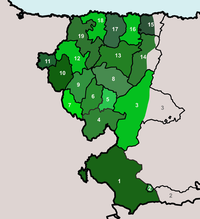Eonavian
| Galician-Asturian | |
|---|---|
| gallego-asturiano, eonaviego | |
| Pronunciation | ɡäˌʝeɣo ästuˈɾjäno̯, e̯onäˈβjɛɣo̯ |
| Native to | Spain |
| Region | Asturias |
|
Native speakers
|
45,000 (2002) |
|
Indo-European
|
|
| Latin (Asturian alphabet) | |
| Official status | |
|
Recognised minority
language in |
|
| Regulated by | Academia de la Llingua Asturiana |
| Language codes | |
| ISO 639-3 | – |
|
Linguist list
|
glg-eon |
| Glottolog | None |
| Linguasphere | 51-AAA-cae |

Linguistic area of Eonavian language
|
|
Galician-Asturian or Eonavian (official name by Act 1/1998, March 23 of Principality of Asturias;autonym: eonaviego, gallego-asturiano; Asturian: eonaviegu, gallego-asturianu; Galician: eonaviego, galego-asturiano) is a set of Romance dialects or falas whose linguistic dominion extends into the zone of Asturias between the Eo River and Navia River (or more specifically the Eo and the Frejulfe River). The dialects have been variously classified as the northeastern varieties of Galician, as a linguistic group of its own, or as a Galician dialect of transition to the Astur-Leonese group.
The area where the dialects are spoken includes the Asturian municipalities of Boal, Castropol, Coaña, Eilao, El Franco, Grandas de Salime, Pezós, San Martín de Ozcos, Santalla de Ozcos, Santiso de Abres, Tapia de Casariego, Taramundi, A Veiga, Vilanova de Ozcos, and partially those of Navia, Ibias, Villayón, and Allande.
...
Wikipedia
